Reflection on Public Health and Social Care: Case Study Analysis
VerifiedAdded on 2023/02/01
|9
|2909
|39
Report
AI Summary
This report presents a reflective analysis of a student's practice placement in a pediatric ward, focusing on the application of public health and social care principles. The report begins with an introduction to reflective practice, its significance in social work, and its application to the student's experience. It then provides a comprehensive overview of public health, its evolution, and its importance in protecting and promoting community health. The student describes their placement as a nurse assistant in a city hospital's pediatric ward, outlining their role, responsibilities, and the hospital's environment. The report further details the student's tasks, including patient care, medication administration, and adherence to nursing practice standards. The importance of partnership working within the healthcare team is also discussed. The report concludes with an account of a specific incident, highlighting the student's learning and the role of reflection in improving practice. This report offers valuable insights into the challenges and rewards of working in a pediatric healthcare setting, underscoring the importance of reflection, teamwork, and adherence to ethical guidelines in providing quality patient care.
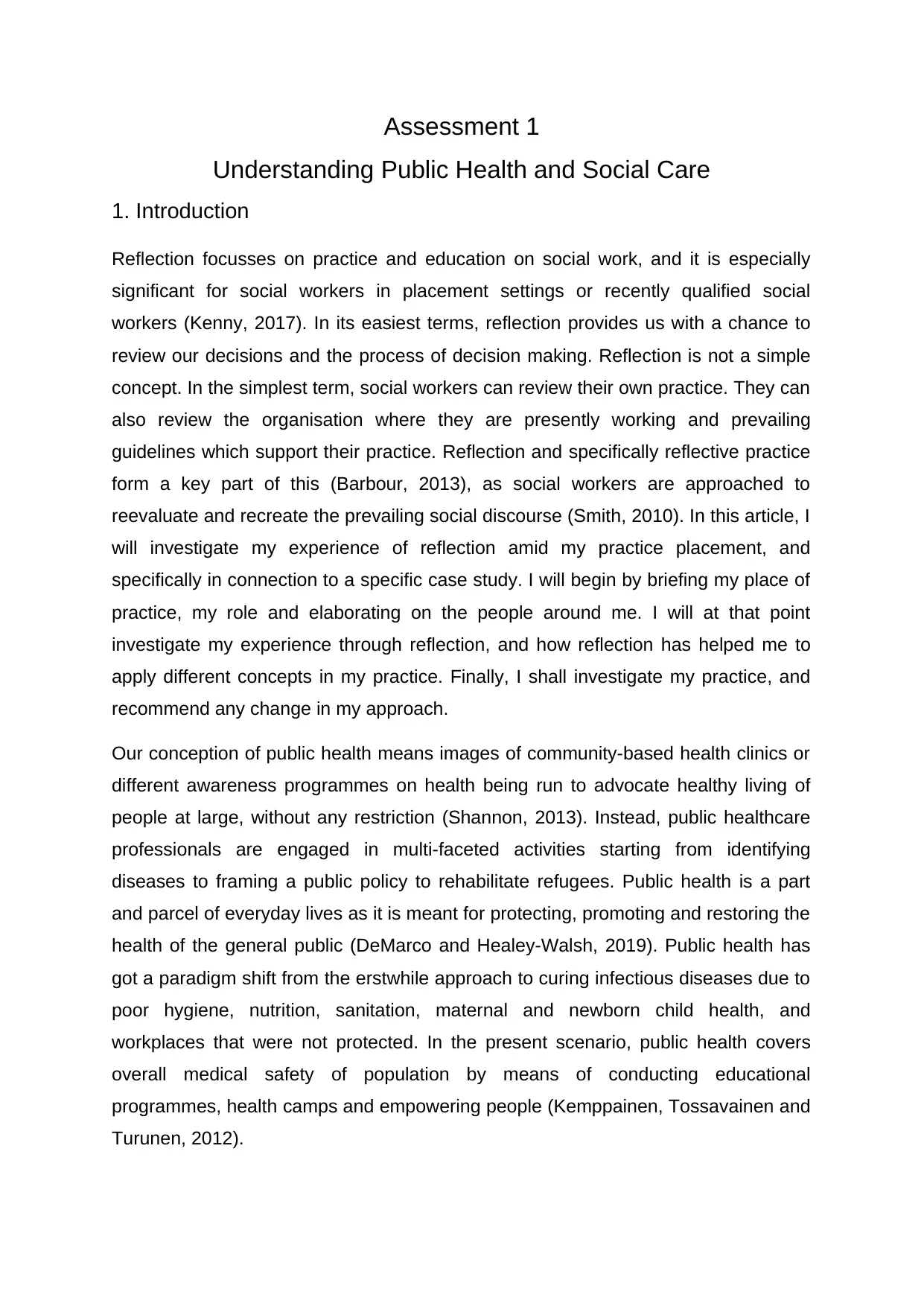
Assessment 1
Understanding Public Health and Social Care
1. Introduction
Reflection focusses on practice and education on social work, and it is especially
significant for social workers in placement settings or recently qualified social
workers (Kenny, 2017). In its easiest terms, reflection provides us with a chance to
review our decisions and the process of decision making. Reflection is not a simple
concept. In the simplest term, social workers can review their own practice. They can
also review the organisation where they are presently working and prevailing
guidelines which support their practice. Reflection and specifically reflective practice
form a key part of this (Barbour, 2013), as social workers are approached to
reevaluate and recreate the prevailing social discourse (Smith, 2010). In this article, I
will investigate my experience of reflection amid my practice placement, and
specifically in connection to a specific case study. I will begin by briefing my place of
practice, my role and elaborating on the people around me. I will at that point
investigate my experience through reflection, and how reflection has helped me to
apply different concepts in my practice. Finally, I shall investigate my practice, and
recommend any change in my approach.
Our conception of public health means images of community-based health clinics or
different awareness programmes on health being run to advocate healthy living of
people at large, without any restriction (Shannon, 2013). Instead, public healthcare
professionals are engaged in multi-faceted activities starting from identifying
diseases to framing a public policy to rehabilitate refugees. Public health is a part
and parcel of everyday lives as it is meant for protecting, promoting and restoring the
health of the general public (DeMarco and Healey-Walsh, 2019). Public health has
got a paradigm shift from the erstwhile approach to curing infectious diseases due to
poor hygiene, nutrition, sanitation, maternal and newborn child health, and
workplaces that were not protected. In the present scenario, public health covers
overall medical safety of population by means of conducting educational
programmes, health camps and empowering people (Kemppainen, Tossavainen and
Turunen, 2012).
Understanding Public Health and Social Care
1. Introduction
Reflection focusses on practice and education on social work, and it is especially
significant for social workers in placement settings or recently qualified social
workers (Kenny, 2017). In its easiest terms, reflection provides us with a chance to
review our decisions and the process of decision making. Reflection is not a simple
concept. In the simplest term, social workers can review their own practice. They can
also review the organisation where they are presently working and prevailing
guidelines which support their practice. Reflection and specifically reflective practice
form a key part of this (Barbour, 2013), as social workers are approached to
reevaluate and recreate the prevailing social discourse (Smith, 2010). In this article, I
will investigate my experience of reflection amid my practice placement, and
specifically in connection to a specific case study. I will begin by briefing my place of
practice, my role and elaborating on the people around me. I will at that point
investigate my experience through reflection, and how reflection has helped me to
apply different concepts in my practice. Finally, I shall investigate my practice, and
recommend any change in my approach.
Our conception of public health means images of community-based health clinics or
different awareness programmes on health being run to advocate healthy living of
people at large, without any restriction (Shannon, 2013). Instead, public healthcare
professionals are engaged in multi-faceted activities starting from identifying
diseases to framing a public policy to rehabilitate refugees. Public health is a part
and parcel of everyday lives as it is meant for protecting, promoting and restoring the
health of the general public (DeMarco and Healey-Walsh, 2019). Public health has
got a paradigm shift from the erstwhile approach to curing infectious diseases due to
poor hygiene, nutrition, sanitation, maternal and newborn child health, and
workplaces that were not protected. In the present scenario, public health covers
overall medical safety of population by means of conducting educational
programmes, health camps and empowering people (Kemppainen, Tossavainen and
Turunen, 2012).
Paraphrase This Document
Need a fresh take? Get an instant paraphrase of this document with our AI Paraphraser
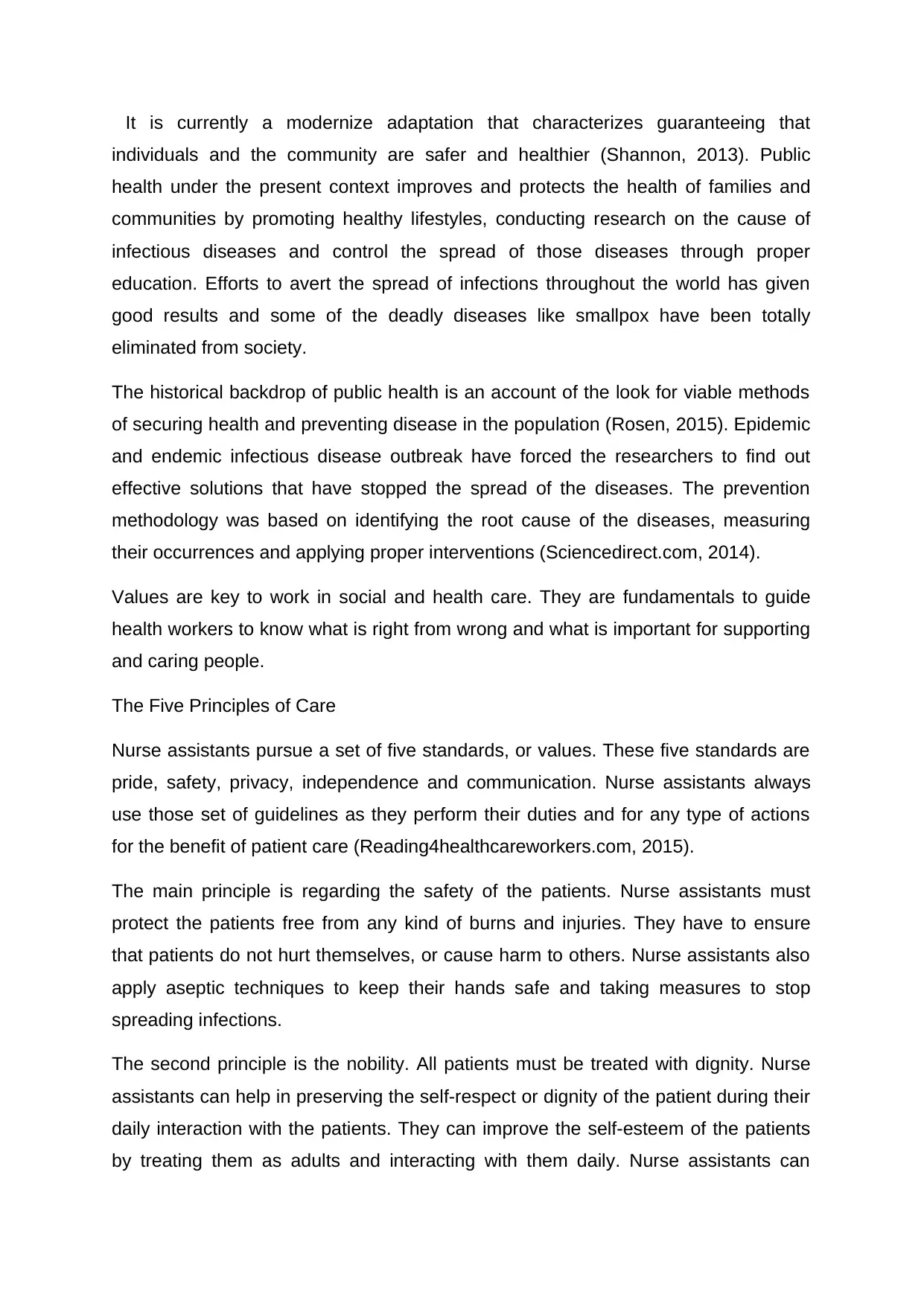
It is currently a modernize adaptation that characterizes guaranteeing that
individuals and the community are safer and healthier (Shannon, 2013). Public
health under the present context improves and protects the health of families and
communities by promoting healthy lifestyles, conducting research on the cause of
infectious diseases and control the spread of those diseases through proper
education. Efforts to avert the spread of infections throughout the world has given
good results and some of the deadly diseases like smallpox have been totally
eliminated from society.
The historical backdrop of public health is an account of the look for viable methods
of securing health and preventing disease in the population (Rosen, 2015). Epidemic
and endemic infectious disease outbreak have forced the researchers to find out
effective solutions that have stopped the spread of the diseases. The prevention
methodology was based on identifying the root cause of the diseases, measuring
their occurrences and applying proper interventions (Sciencedirect.com, 2014).
Values are key to work in social and health care. They are fundamentals to guide
health workers to know what is right from wrong and what is important for supporting
and caring people.
The Five Principles of Care
Nurse assistants pursue a set of five standards, or values. These five standards are
pride, safety, privacy, independence and communication. Nurse assistants always
use those set of guidelines as they perform their duties and for any type of actions
for the benefit of patient care (Reading4healthcareworkers.com, 2015).
The main principle is regarding the safety of the patients. Nurse assistants must
protect the patients free from any kind of burns and injuries. They have to ensure
that patients do not hurt themselves, or cause harm to others. Nurse assistants also
apply aseptic techniques to keep their hands safe and taking measures to stop
spreading infections.
The second principle is the nobility. All patients must be treated with dignity. Nurse
assistants can help in preserving the self-respect or dignity of the patient during their
daily interaction with the patients. They can improve the self-esteem of the patients
by treating them as adults and interacting with them daily. Nurse assistants can
individuals and the community are safer and healthier (Shannon, 2013). Public
health under the present context improves and protects the health of families and
communities by promoting healthy lifestyles, conducting research on the cause of
infectious diseases and control the spread of those diseases through proper
education. Efforts to avert the spread of infections throughout the world has given
good results and some of the deadly diseases like smallpox have been totally
eliminated from society.
The historical backdrop of public health is an account of the look for viable methods
of securing health and preventing disease in the population (Rosen, 2015). Epidemic
and endemic infectious disease outbreak have forced the researchers to find out
effective solutions that have stopped the spread of the diseases. The prevention
methodology was based on identifying the root cause of the diseases, measuring
their occurrences and applying proper interventions (Sciencedirect.com, 2014).
Values are key to work in social and health care. They are fundamentals to guide
health workers to know what is right from wrong and what is important for supporting
and caring people.
The Five Principles of Care
Nurse assistants pursue a set of five standards, or values. These five standards are
pride, safety, privacy, independence and communication. Nurse assistants always
use those set of guidelines as they perform their duties and for any type of actions
for the benefit of patient care (Reading4healthcareworkers.com, 2015).
The main principle is regarding the safety of the patients. Nurse assistants must
protect the patients free from any kind of burns and injuries. They have to ensure
that patients do not hurt themselves, or cause harm to others. Nurse assistants also
apply aseptic techniques to keep their hands safe and taking measures to stop
spreading infections.
The second principle is the nobility. All patients must be treated with dignity. Nurse
assistants can help in preserving the self-respect or dignity of the patient during their
daily interaction with the patients. They can improve the self-esteem of the patients
by treating them as adults and interacting with them daily. Nurse assistants can
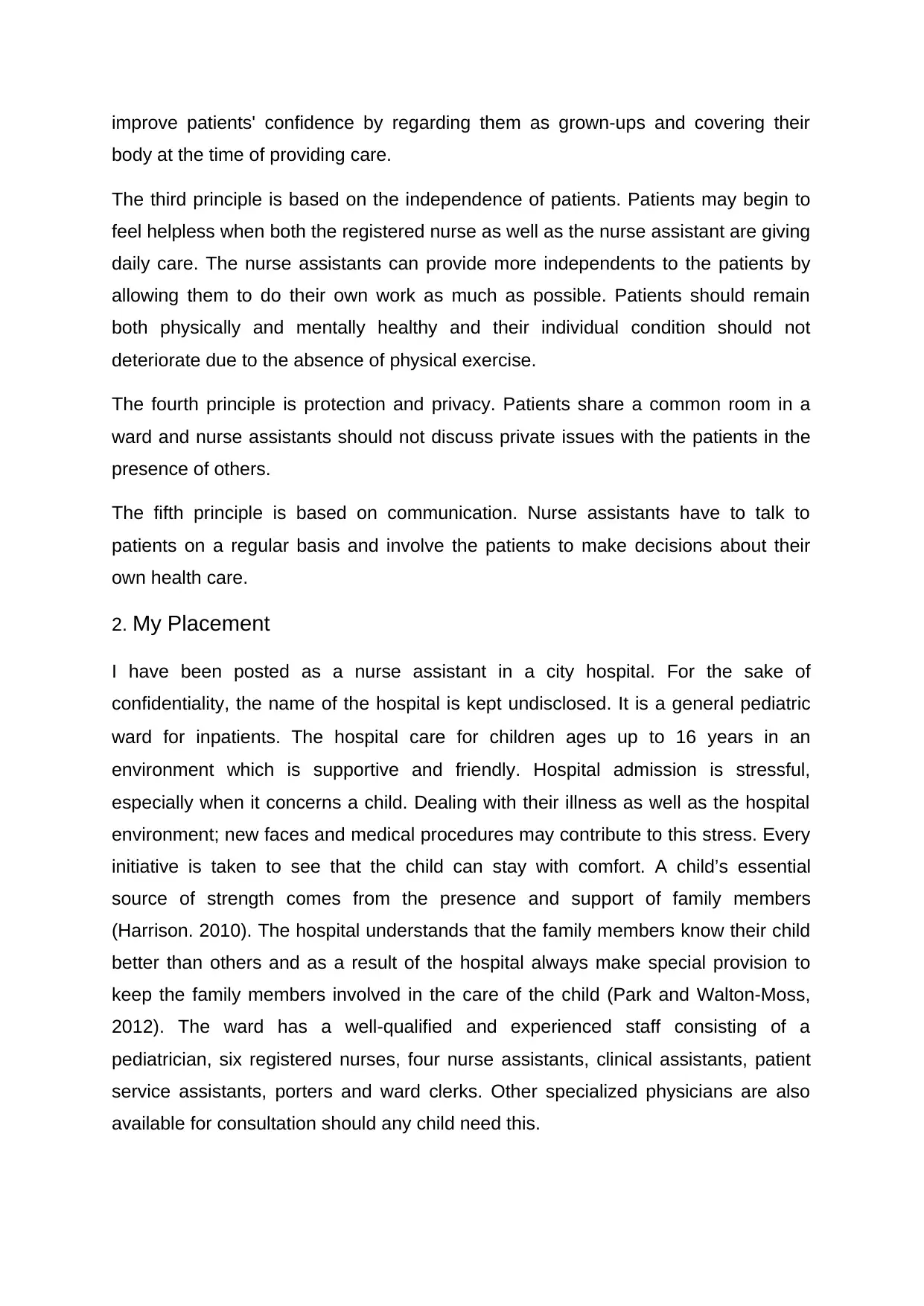
improve patients' confidence by regarding them as grown-ups and covering their
body at the time of providing care.
The third principle is based on the independence of patients. Patients may begin to
feel helpless when both the registered nurse as well as the nurse assistant are giving
daily care. The nurse assistants can provide more independents to the patients by
allowing them to do their own work as much as possible. Patients should remain
both physically and mentally healthy and their individual condition should not
deteriorate due to the absence of physical exercise.
The fourth principle is protection and privacy. Patients share a common room in a
ward and nurse assistants should not discuss private issues with the patients in the
presence of others.
The fifth principle is based on communication. Nurse assistants have to talk to
patients on a regular basis and involve the patients to make decisions about their
own health care.
2. My Placement
I have been posted as a nurse assistant in a city hospital. For the sake of
confidentiality, the name of the hospital is kept undisclosed. It is a general pediatric
ward for inpatients. The hospital care for children ages up to 16 years in an
environment which is supportive and friendly. Hospital admission is stressful,
especially when it concerns a child. Dealing with their illness as well as the hospital
environment; new faces and medical procedures may contribute to this stress. Every
initiative is taken to see that the child can stay with comfort. A child’s essential
source of strength comes from the presence and support of family members
(Harrison. 2010). The hospital understands that the family members know their child
better than others and as a result of the hospital always make special provision to
keep the family members involved in the care of the child (Park and Walton-Moss,
2012). The ward has a well-qualified and experienced staff consisting of a
pediatrician, six registered nurses, four nurse assistants, clinical assistants, patient
service assistants, porters and ward clerks. Other specialized physicians are also
available for consultation should any child need this.
body at the time of providing care.
The third principle is based on the independence of patients. Patients may begin to
feel helpless when both the registered nurse as well as the nurse assistant are giving
daily care. The nurse assistants can provide more independents to the patients by
allowing them to do their own work as much as possible. Patients should remain
both physically and mentally healthy and their individual condition should not
deteriorate due to the absence of physical exercise.
The fourth principle is protection and privacy. Patients share a common room in a
ward and nurse assistants should not discuss private issues with the patients in the
presence of others.
The fifth principle is based on communication. Nurse assistants have to talk to
patients on a regular basis and involve the patients to make decisions about their
own health care.
2. My Placement
I have been posted as a nurse assistant in a city hospital. For the sake of
confidentiality, the name of the hospital is kept undisclosed. It is a general pediatric
ward for inpatients. The hospital care for children ages up to 16 years in an
environment which is supportive and friendly. Hospital admission is stressful,
especially when it concerns a child. Dealing with their illness as well as the hospital
environment; new faces and medical procedures may contribute to this stress. Every
initiative is taken to see that the child can stay with comfort. A child’s essential
source of strength comes from the presence and support of family members
(Harrison. 2010). The hospital understands that the family members know their child
better than others and as a result of the hospital always make special provision to
keep the family members involved in the care of the child (Park and Walton-Moss,
2012). The ward has a well-qualified and experienced staff consisting of a
pediatrician, six registered nurses, four nurse assistants, clinical assistants, patient
service assistants, porters and ward clerks. Other specialized physicians are also
available for consultation should any child need this.
⊘ This is a preview!⊘
Do you want full access?
Subscribe today to unlock all pages.

Trusted by 1+ million students worldwide
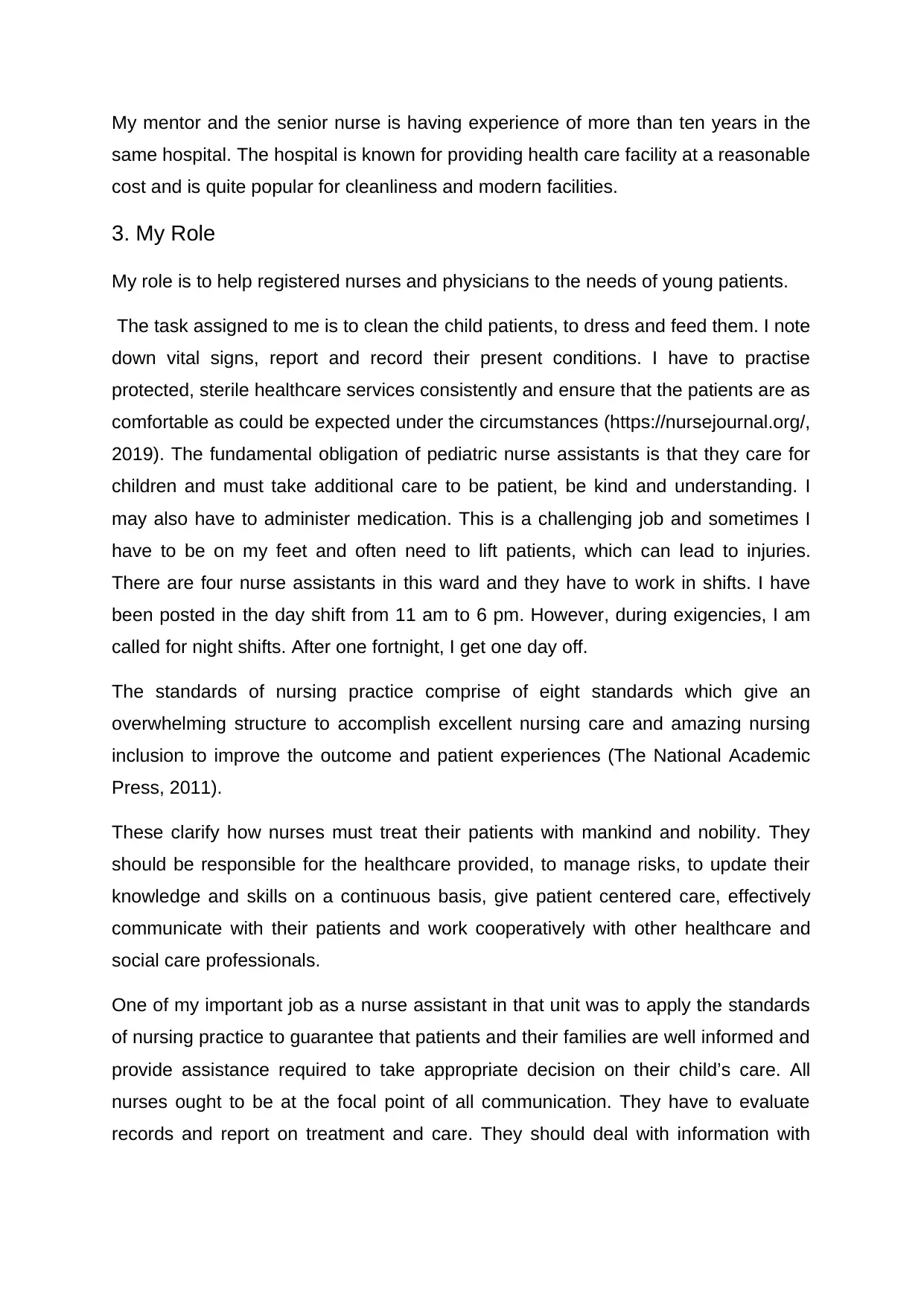
My mentor and the senior nurse is having experience of more than ten years in the
same hospital. The hospital is known for providing health care facility at a reasonable
cost and is quite popular for cleanliness and modern facilities.
3. My Role
My role is to help registered nurses and physicians to the needs of young patients.
The task assigned to me is to clean the child patients, to dress and feed them. I note
down vital signs, report and record their present conditions. I have to practise
protected, sterile healthcare services consistently and ensure that the patients are as
comfortable as could be expected under the circumstances (https://nursejournal.org/,
2019). The fundamental obligation of pediatric nurse assistants is that they care for
children and must take additional care to be patient, be kind and understanding. I
may also have to administer medication. This is a challenging job and sometimes I
have to be on my feet and often need to lift patients, which can lead to injuries.
There are four nurse assistants in this ward and they have to work in shifts. I have
been posted in the day shift from 11 am to 6 pm. However, during exigencies, I am
called for night shifts. After one fortnight, I get one day off.
The standards of nursing practice comprise of eight standards which give an
overwhelming structure to accomplish excellent nursing care and amazing nursing
inclusion to improve the outcome and patient experiences (The National Academic
Press, 2011).
These clarify how nurses must treat their patients with mankind and nobility. They
should be responsible for the healthcare provided, to manage risks, to update their
knowledge and skills on a continuous basis, give patient centered care, effectively
communicate with their patients and work cooperatively with other healthcare and
social care professionals.
One of my important job as a nurse assistant in that unit was to apply the standards
of nursing practice to guarantee that patients and their families are well informed and
provide assistance required to take appropriate decision on their child’s care. All
nurses ought to be at the focal point of all communication. They have to evaluate
records and report on treatment and care. They should deal with information with
same hospital. The hospital is known for providing health care facility at a reasonable
cost and is quite popular for cleanliness and modern facilities.
3. My Role
My role is to help registered nurses and physicians to the needs of young patients.
The task assigned to me is to clean the child patients, to dress and feed them. I note
down vital signs, report and record their present conditions. I have to practise
protected, sterile healthcare services consistently and ensure that the patients are as
comfortable as could be expected under the circumstances (https://nursejournal.org/,
2019). The fundamental obligation of pediatric nurse assistants is that they care for
children and must take additional care to be patient, be kind and understanding. I
may also have to administer medication. This is a challenging job and sometimes I
have to be on my feet and often need to lift patients, which can lead to injuries.
There are four nurse assistants in this ward and they have to work in shifts. I have
been posted in the day shift from 11 am to 6 pm. However, during exigencies, I am
called for night shifts. After one fortnight, I get one day off.
The standards of nursing practice comprise of eight standards which give an
overwhelming structure to accomplish excellent nursing care and amazing nursing
inclusion to improve the outcome and patient experiences (The National Academic
Press, 2011).
These clarify how nurses must treat their patients with mankind and nobility. They
should be responsible for the healthcare provided, to manage risks, to update their
knowledge and skills on a continuous basis, give patient centered care, effectively
communicate with their patients and work cooperatively with other healthcare and
social care professionals.
One of my important job as a nurse assistant in that unit was to apply the standards
of nursing practice to guarantee that patients and their families are well informed and
provide assistance required to take appropriate decision on their child’s care. All
nurses ought to be at the focal point of all communication. They have to evaluate
records and report on treatment and care. They should deal with information with
Paraphrase This Document
Need a fresh take? Get an instant paraphrase of this document with our AI Paraphraser
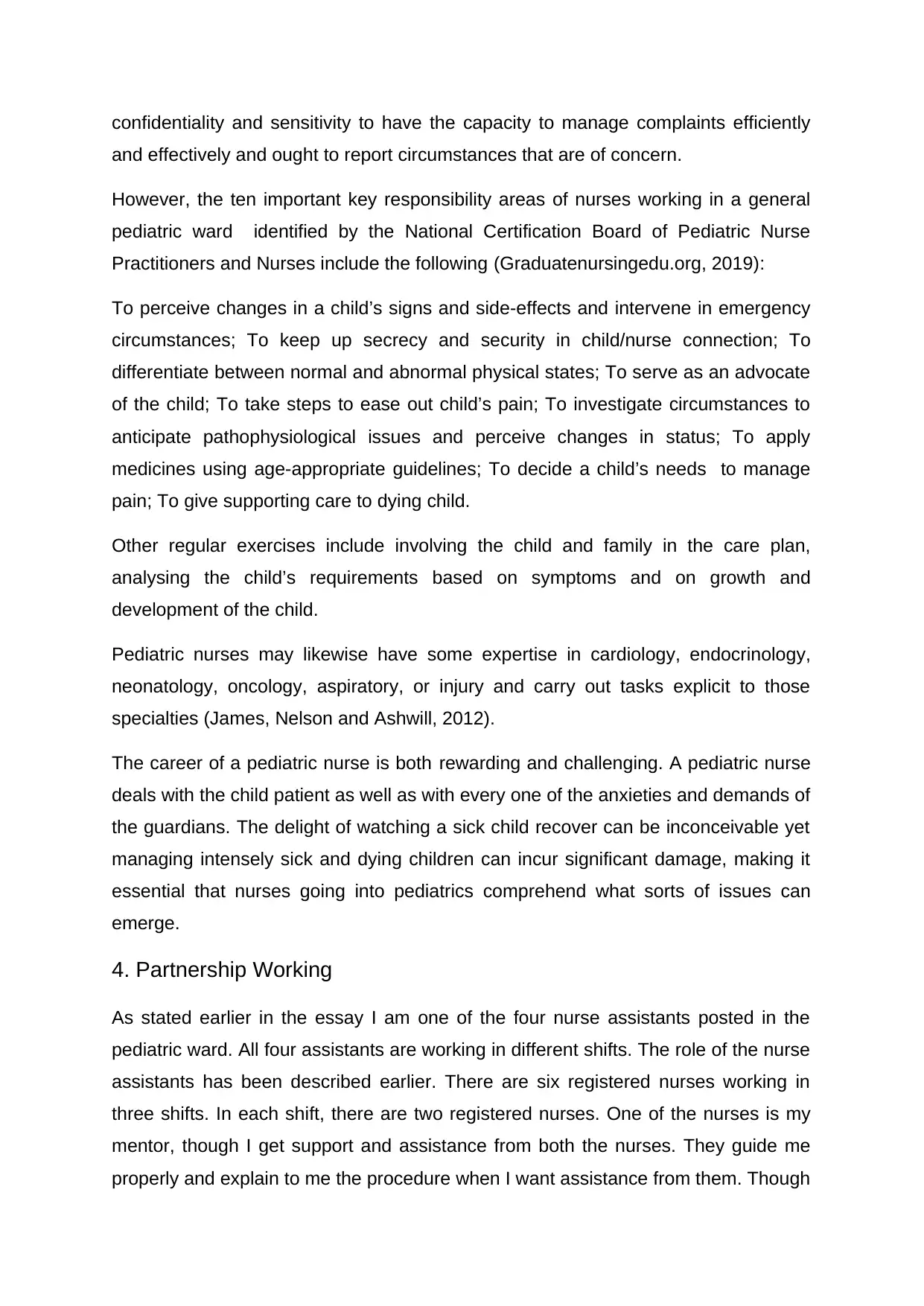
confidentiality and sensitivity to have the capacity to manage complaints efficiently
and effectively and ought to report circumstances that are of concern.
However, the ten important key responsibility areas of nurses working in a general
pediatric ward identified by the National Certification Board of Pediatric Nurse
Practitioners and Nurses include the following (Graduatenursingedu.org, 2019):
To perceive changes in a child’s signs and side-effects and intervene in emergency
circumstances; To keep up secrecy and security in child/nurse connection; To
differentiate between normal and abnormal physical states; To serve as an advocate
of the child; To take steps to ease out child’s pain; To investigate circumstances to
anticipate pathophysiological issues and perceive changes in status; To apply
medicines using age-appropriate guidelines; To decide a child’s needs to manage
pain; To give supporting care to dying child.
Other regular exercises include involving the child and family in the care plan,
analysing the child’s requirements based on symptoms and on growth and
development of the child.
Pediatric nurses may likewise have some expertise in cardiology, endocrinology,
neonatology, oncology, aspiratory, or injury and carry out tasks explicit to those
specialties (James, Nelson and Ashwill, 2012).
The career of a pediatric nurse is both rewarding and challenging. A pediatric nurse
deals with the child patient as well as with every one of the anxieties and demands of
the guardians. The delight of watching a sick child recover can be inconceivable yet
managing intensely sick and dying children can incur significant damage, making it
essential that nurses going into pediatrics comprehend what sorts of issues can
emerge.
4. Partnership Working
As stated earlier in the essay I am one of the four nurse assistants posted in the
pediatric ward. All four assistants are working in different shifts. The role of the nurse
assistants has been described earlier. There are six registered nurses working in
three shifts. In each shift, there are two registered nurses. One of the nurses is my
mentor, though I get support and assistance from both the nurses. They guide me
properly and explain to me the procedure when I want assistance from them. Though
and effectively and ought to report circumstances that are of concern.
However, the ten important key responsibility areas of nurses working in a general
pediatric ward identified by the National Certification Board of Pediatric Nurse
Practitioners and Nurses include the following (Graduatenursingedu.org, 2019):
To perceive changes in a child’s signs and side-effects and intervene in emergency
circumstances; To keep up secrecy and security in child/nurse connection; To
differentiate between normal and abnormal physical states; To serve as an advocate
of the child; To take steps to ease out child’s pain; To investigate circumstances to
anticipate pathophysiological issues and perceive changes in status; To apply
medicines using age-appropriate guidelines; To decide a child’s needs to manage
pain; To give supporting care to dying child.
Other regular exercises include involving the child and family in the care plan,
analysing the child’s requirements based on symptoms and on growth and
development of the child.
Pediatric nurses may likewise have some expertise in cardiology, endocrinology,
neonatology, oncology, aspiratory, or injury and carry out tasks explicit to those
specialties (James, Nelson and Ashwill, 2012).
The career of a pediatric nurse is both rewarding and challenging. A pediatric nurse
deals with the child patient as well as with every one of the anxieties and demands of
the guardians. The delight of watching a sick child recover can be inconceivable yet
managing intensely sick and dying children can incur significant damage, making it
essential that nurses going into pediatrics comprehend what sorts of issues can
emerge.
4. Partnership Working
As stated earlier in the essay I am one of the four nurse assistants posted in the
pediatric ward. All four assistants are working in different shifts. The role of the nurse
assistants has been described earlier. There are six registered nurses working in
three shifts. In each shift, there are two registered nurses. One of the nurses is my
mentor, though I get support and assistance from both the nurses. They guide me
properly and explain to me the procedure when I want assistance from them. Though
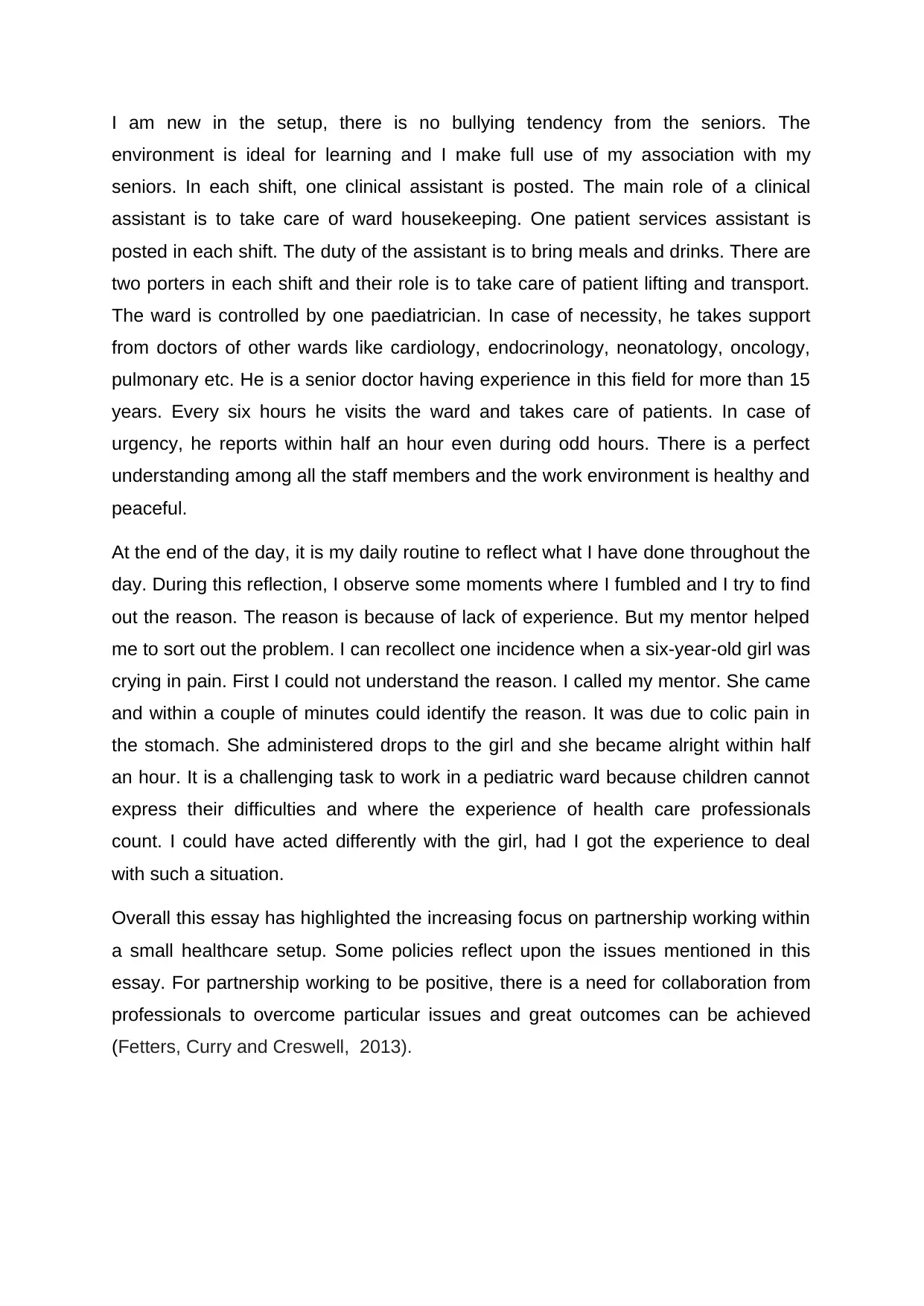
I am new in the setup, there is no bullying tendency from the seniors. The
environment is ideal for learning and I make full use of my association with my
seniors. In each shift, one clinical assistant is posted. The main role of a clinical
assistant is to take care of ward housekeeping. One patient services assistant is
posted in each shift. The duty of the assistant is to bring meals and drinks. There are
two porters in each shift and their role is to take care of patient lifting and transport.
The ward is controlled by one paediatrician. In case of necessity, he takes support
from doctors of other wards like cardiology, endocrinology, neonatology, oncology,
pulmonary etc. He is a senior doctor having experience in this field for more than 15
years. Every six hours he visits the ward and takes care of patients. In case of
urgency, he reports within half an hour even during odd hours. There is a perfect
understanding among all the staff members and the work environment is healthy and
peaceful.
At the end of the day, it is my daily routine to reflect what I have done throughout the
day. During this reflection, I observe some moments where I fumbled and I try to find
out the reason. The reason is because of lack of experience. But my mentor helped
me to sort out the problem. I can recollect one incidence when a six-year-old girl was
crying in pain. First I could not understand the reason. I called my mentor. She came
and within a couple of minutes could identify the reason. It was due to colic pain in
the stomach. She administered drops to the girl and she became alright within half
an hour. It is a challenging task to work in a pediatric ward because children cannot
express their difficulties and where the experience of health care professionals
count. I could have acted differently with the girl, had I got the experience to deal
with such a situation.
Overall this essay has highlighted the increasing focus on partnership working within
a small healthcare setup. Some policies reflect upon the issues mentioned in this
essay. For partnership working to be positive, there is a need for collaboration from
professionals to overcome particular issues and great outcomes can be achieved
(Fetters, Curry and Creswell, 2013).
environment is ideal for learning and I make full use of my association with my
seniors. In each shift, one clinical assistant is posted. The main role of a clinical
assistant is to take care of ward housekeeping. One patient services assistant is
posted in each shift. The duty of the assistant is to bring meals and drinks. There are
two porters in each shift and their role is to take care of patient lifting and transport.
The ward is controlled by one paediatrician. In case of necessity, he takes support
from doctors of other wards like cardiology, endocrinology, neonatology, oncology,
pulmonary etc. He is a senior doctor having experience in this field for more than 15
years. Every six hours he visits the ward and takes care of patients. In case of
urgency, he reports within half an hour even during odd hours. There is a perfect
understanding among all the staff members and the work environment is healthy and
peaceful.
At the end of the day, it is my daily routine to reflect what I have done throughout the
day. During this reflection, I observe some moments where I fumbled and I try to find
out the reason. The reason is because of lack of experience. But my mentor helped
me to sort out the problem. I can recollect one incidence when a six-year-old girl was
crying in pain. First I could not understand the reason. I called my mentor. She came
and within a couple of minutes could identify the reason. It was due to colic pain in
the stomach. She administered drops to the girl and she became alright within half
an hour. It is a challenging task to work in a pediatric ward because children cannot
express their difficulties and where the experience of health care professionals
count. I could have acted differently with the girl, had I got the experience to deal
with such a situation.
Overall this essay has highlighted the increasing focus on partnership working within
a small healthcare setup. Some policies reflect upon the issues mentioned in this
essay. For partnership working to be positive, there is a need for collaboration from
professionals to overcome particular issues and great outcomes can be achieved
(Fetters, Curry and Creswell, 2013).
⊘ This is a preview!⊘
Do you want full access?
Subscribe today to unlock all pages.

Trusted by 1+ million students worldwide

References
Paraphrase This Document
Need a fresh take? Get an instant paraphrase of this document with our AI Paraphraser
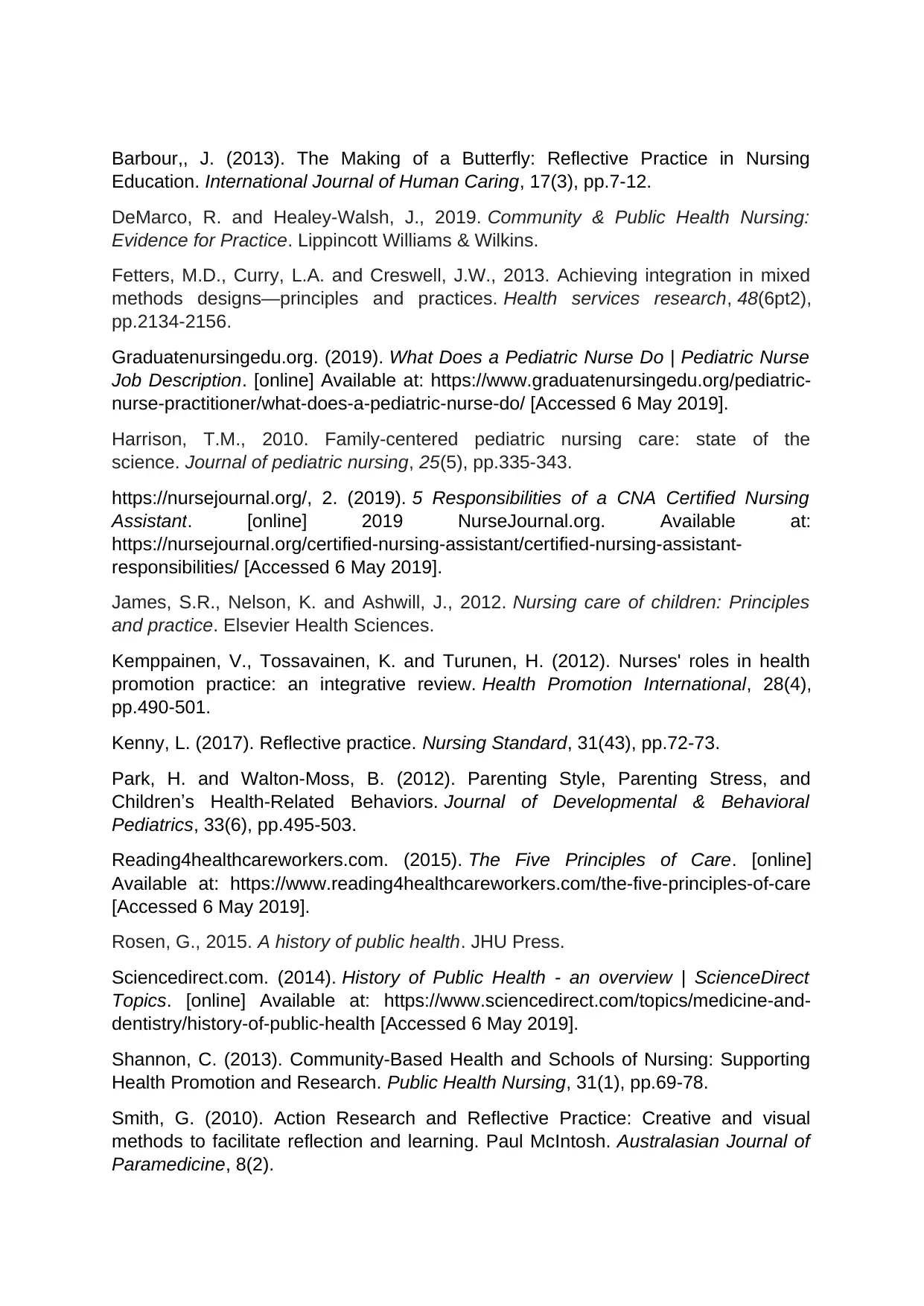
Barbour,, J. (2013). The Making of a Butterfly: Reflective Practice in Nursing
Education. International Journal of Human Caring, 17(3), pp.7-12.
DeMarco, R. and Healey-Walsh, J., 2019. Community & Public Health Nursing:
Evidence for Practice. Lippincott Williams & Wilkins.
Fetters, M.D., Curry, L.A. and Creswell, J.W., 2013. Achieving integration in mixed
methods designs—principles and practices. Health services research, 48(6pt2),
pp.2134-2156.
Graduatenursingedu.org. (2019). What Does a Pediatric Nurse Do | Pediatric Nurse
Job Description. [online] Available at: https://www.graduatenursingedu.org/pediatric-
nurse-practitioner/what-does-a-pediatric-nurse-do/ [Accessed 6 May 2019].
Harrison, T.M., 2010. Family-centered pediatric nursing care: state of the
science. Journal of pediatric nursing, 25(5), pp.335-343.
https://nursejournal.org/, 2. (2019). 5 Responsibilities of a CNA Certified Nursing
Assistant. [online] 2019 NurseJournal.org. Available at:
https://nursejournal.org/certified-nursing-assistant/certified-nursing-assistant-
responsibilities/ [Accessed 6 May 2019].
James, S.R., Nelson, K. and Ashwill, J., 2012. Nursing care of children: Principles
and practice. Elsevier Health Sciences.
Kemppainen, V., Tossavainen, K. and Turunen, H. (2012). Nurses' roles in health
promotion practice: an integrative review. Health Promotion International, 28(4),
pp.490-501.
Kenny, L. (2017). Reflective practice. Nursing Standard, 31(43), pp.72-73.
Park, H. and Walton-Moss, B. (2012). Parenting Style, Parenting Stress, and
Childrenʼs Health-Related Behaviors. Journal of Developmental & Behavioral
Pediatrics, 33(6), pp.495-503.
Reading4healthcareworkers.com. (2015). The Five Principles of Care. [online]
Available at: https://www.reading4healthcareworkers.com/the-five-principles-of-care
[Accessed 6 May 2019].
Rosen, G., 2015. A history of public health. JHU Press.
Sciencedirect.com. (2014). History of Public Health - an overview | ScienceDirect
Topics. [online] Available at: https://www.sciencedirect.com/topics/medicine-and-
dentistry/history-of-public-health [Accessed 6 May 2019].
Shannon, C. (2013). Community-Based Health and Schools of Nursing: Supporting
Health Promotion and Research. Public Health Nursing, 31(1), pp.69-78.
Smith, G. (2010). Action Research and Reflective Practice: Creative and visual
methods to facilitate reflection and learning. Paul McIntosh. Australasian Journal of
Paramedicine, 8(2).
Education. International Journal of Human Caring, 17(3), pp.7-12.
DeMarco, R. and Healey-Walsh, J., 2019. Community & Public Health Nursing:
Evidence for Practice. Lippincott Williams & Wilkins.
Fetters, M.D., Curry, L.A. and Creswell, J.W., 2013. Achieving integration in mixed
methods designs—principles and practices. Health services research, 48(6pt2),
pp.2134-2156.
Graduatenursingedu.org. (2019). What Does a Pediatric Nurse Do | Pediatric Nurse
Job Description. [online] Available at: https://www.graduatenursingedu.org/pediatric-
nurse-practitioner/what-does-a-pediatric-nurse-do/ [Accessed 6 May 2019].
Harrison, T.M., 2010. Family-centered pediatric nursing care: state of the
science. Journal of pediatric nursing, 25(5), pp.335-343.
https://nursejournal.org/, 2. (2019). 5 Responsibilities of a CNA Certified Nursing
Assistant. [online] 2019 NurseJournal.org. Available at:
https://nursejournal.org/certified-nursing-assistant/certified-nursing-assistant-
responsibilities/ [Accessed 6 May 2019].
James, S.R., Nelson, K. and Ashwill, J., 2012. Nursing care of children: Principles
and practice. Elsevier Health Sciences.
Kemppainen, V., Tossavainen, K. and Turunen, H. (2012). Nurses' roles in health
promotion practice: an integrative review. Health Promotion International, 28(4),
pp.490-501.
Kenny, L. (2017). Reflective practice. Nursing Standard, 31(43), pp.72-73.
Park, H. and Walton-Moss, B. (2012). Parenting Style, Parenting Stress, and
Childrenʼs Health-Related Behaviors. Journal of Developmental & Behavioral
Pediatrics, 33(6), pp.495-503.
Reading4healthcareworkers.com. (2015). The Five Principles of Care. [online]
Available at: https://www.reading4healthcareworkers.com/the-five-principles-of-care
[Accessed 6 May 2019].
Rosen, G., 2015. A history of public health. JHU Press.
Sciencedirect.com. (2014). History of Public Health - an overview | ScienceDirect
Topics. [online] Available at: https://www.sciencedirect.com/topics/medicine-and-
dentistry/history-of-public-health [Accessed 6 May 2019].
Shannon, C. (2013). Community-Based Health and Schools of Nursing: Supporting
Health Promotion and Research. Public Health Nursing, 31(1), pp.69-78.
Smith, G. (2010). Action Research and Reflective Practice: Creative and visual
methods to facilitate reflection and learning. Paul McIntosh. Australasian Journal of
Paramedicine, 8(2).
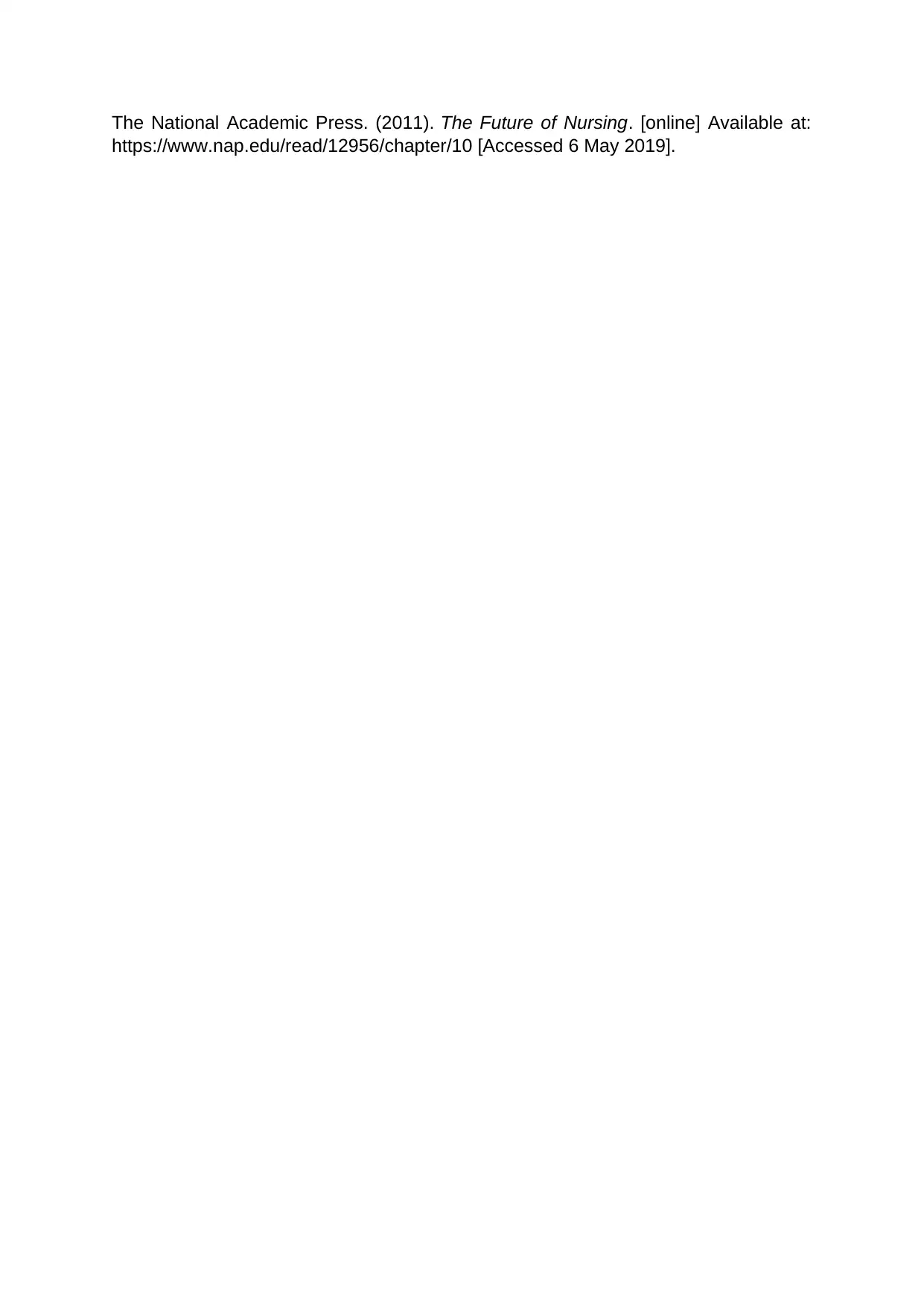
The National Academic Press. (2011). The Future of Nursing. [online] Available at:
https://www.nap.edu/read/12956/chapter/10 [Accessed 6 May 2019].
https://www.nap.edu/read/12956/chapter/10 [Accessed 6 May 2019].
⊘ This is a preview!⊘
Do you want full access?
Subscribe today to unlock all pages.

Trusted by 1+ million students worldwide
1 out of 9
Related Documents
Your All-in-One AI-Powered Toolkit for Academic Success.
+13062052269
info@desklib.com
Available 24*7 on WhatsApp / Email
![[object Object]](/_next/static/media/star-bottom.7253800d.svg)
Unlock your academic potential
Copyright © 2020–2025 A2Z Services. All Rights Reserved. Developed and managed by ZUCOL.





